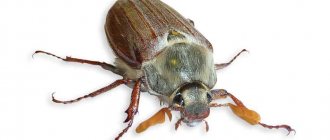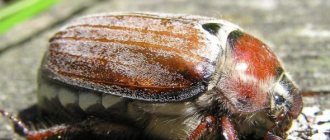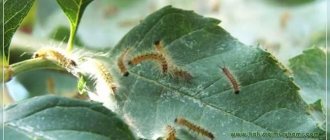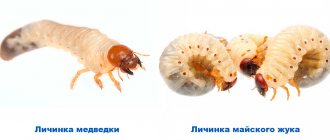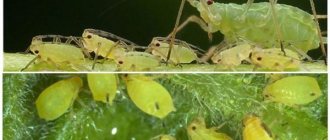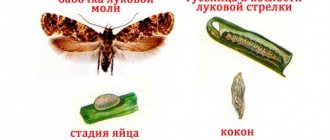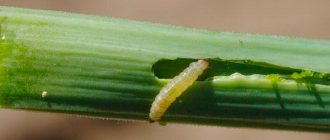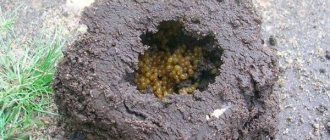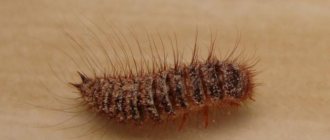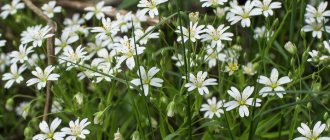Description of the pest
The mole cricket is an insect, a representative of the order Orthoptera.
The adult specimen is characterized by significant size (up to 6 cm). For orientation in space, whiskers are provided, and the limbs are designed so that the insect has the opportunity to dig the soil. Life expectancy is 5 years. An adult mole cricket feeds on plant roots and can damage up to 15 plants per night
The mole cricket is distributed throughout Russia (with the exception of the regions of the North and East), Europe, and Asia. Acceptable conditions for existence in the ground are from +10 degrees or more. The pest is nocturnal, during which time the mole cricket climbs to the soil surface. The insect reaches a soil depth of up to 2 m. It overwinters closer to the surface (at a level of no more than 15 cm from the soil surface). This insect moves quickly, can swim, fly (rises to a height of up to 5 m).
Signs of appearance
Considering that pests do not appear during the day, they are not easy to detect. However, according to some signs, it is quite possible to assume the appearance of a mole cricket:
- General destruction of seedlings: leaf lethargy appears, plants wither;
- Violation of the integrity of root crops;
- The soil becomes loosened, piles of soil and passages are revealed;
- Holes in the ground.
External signs of eggs
The pest reproduces very quickly, as there are about 500 eggs in one clutch. The mating season lasts several months: from May to July. Eggs of the mole cricket pest are found under a layer of soil, in manure or a garbage heap. The insect builds a nest. This is a small chamber: approximately 6x6 cm. The walls are sealed. The nest of a mole cricket contains beige or yellow-brown offspring.
The chamber is filled with yellow or light brown eggs, similar to ant eggs, but larger.
Externally, the eggs resemble ant eggs. However, the larger size makes it possible to verify that these are the offspring of mole crickets. The egg reaches a length of 3.5 mm. The incubation period lasts about three weeks. In order for the offspring to develop normally, the mole cricket sets up its nest at a depth of no more than 15 cm from the surface of the earth. This ensures the supply of oxygen. The female takes care of the offspring and periodically turns the eggs, which reduces the risk of mold.
Description of the larva
Considering that an adult insect lives on average 5 years, it takes 1-2 years for the offspring to develop. During this period, the young go through 4 stages. After emerging from the shells, mole cricket larvae develop to a size of 1.5-3.5 cm. Formation in more acceptable conditions (ambient temperature, opportunity to feed) occurs faster.
With each moult, it becomes more and more similar to an adult: the body darkens and takes on shape.
In terms of external characteristics, the mole cricket larva resembles an adult. The only difference is the sizes. Thus, young animals are half as long as mature insects. The larva goes through several stages of molting. Gradually she reaches sexual maturity and acquires the ability to reproduce. In one season, as happens with most insects, the offspring of the mole cricket does not have time to develop and remains to overwinter, remaining in the larval form.
During the cold season, some of the offspring die, because not all individuals tolerate frost well. This ability is influenced by the supply of nutrients accumulated during the warm season. This factor also determines the female’s fertility in the future. Immediately after emerging from the eggs, the larva begins to feed. The source of food for her at this stage is the remains of the protective shell, as well as salivary secretions, which the female used to build the chamber/nest.
When the offspring grows up (closer to autumn), the source of food is the food familiar to adult mole crickets: roots, root crops, lower sections of the stems of plantings. As they develop, the larvae become more voracious. At first, the offspring move along ready-made passages dug by the parent insects. When the larvae's capabilities increase, they begin to dig the ground on their own. This happens forcedly, as there is a need to find new sources of food.
Where can flea larvae be found?
Flea eggs parasites in the literal sense of the word , because they eat only organic remains. Therefore, they can be found in secluded warm places, in garbage, in cages with animals. The larvae do not live on the body of pets, but they can be seen in large quantities in doghouses, on beds and bedding. Comfortable climatic conditions suitable for the development of parasites and direct access to food distinguish the above-mentioned places.
You need to look for eggs in your apartment and garden:
- in places where cats, dogs and other animals are kept and rest;
- storage rooms filled with garbage;
- places where rags are stored;
- in crevices, corners, cracks in floors;
- under baseboards;
- under the wallpaper;
- chicken coops, under accumulations of garbage, rags and dried droppings.
- in flowerpots;
- boxes for storing fruits and vegetables;
- under the trash can;
- inside pillows or warm blankets;
- under the upholstery of upholstered furniture.
Flea larvae can be found in the most unexpected places:
The larvae prefer places with high levels of humidity, which favors their active development.
Attention: flea eggs themselves cannot appear anywhere. If they were found, then adult fleas are also parasitizing in the room! Developing bloodsuckers prefer areas in the immediate habitat of humans or animals.
Medvedka - description and photo
- At the end of the abdomen, the mole cricket has two paired appendages in the form of a thread - cerci, up to 1 cm long. At the bottom of the abdomen there are numerous golden hairs. On top there are elytra, under which there are large wings, which when folded look like thin scales.
- On the head there are two large eyes, long mustaches and tentacles near the mouthparts (photo 6, photo 7). The pair of forelimbs is modified and consists of short, powerful paws with thick shins, which are an excellent tool for digging the ground.
The mole cricket begins to be active at the end of May, when the mating season begins. At this time, female insects leave their underground shelters and crawl to the surface of the earth to meet the male.
After mating, the female prepares a nest at a depth of 10–15 cm and lays eggs there. One of the two passages leading to the nest opens onto the surface of the earth. After rain or watering, the mole cricket clears the passage of clogged soil, leaving piles of loose soil on the surface, from which the location of the insect’s nests is clearly visible.
Adult mole crickets overwinter together with larvae in compost or in the ground at a depth of more than 2 meters.
As mentioned earlier, the mole cricket is a very large insect with small hairs on its body. Its shell is brown on top and yellow-brown underneath. The body length can reach from 3 to 5 centimeters, and the thickness is 1-1.5 cm. The head is located straight in relation to the body, and their axes completely coincide.
The insect's foredorsum is massive, flat, the lateral lobes slightly hang downwards. It is this feature that will help you recognize the cabbage plant. The front part and head have a strong chitinous shell, which is why it is compared to a crayfish. It helps the insect when digging underground tunnels, as it has the properties to successfully compact and push the earth.
The belly of the mole cricket is thick, its diameter reaches approximately 1 centimeter. In males and females, the anal and genital plates are located on it, but no ovipositor was found in females. The last plate of the abdomen has cerci, also called caudal appendages, which look like antennae. More details about mole cricket reproduction are described in a separate section below.
Mole crickets have 3 pairs of limbs. The front legs are very strong, designed for digging the ground. The thigh and lower leg are widened, and the legs are shortened. There are four spikes on the shin, which are painted black, and two on the paw. They help the insect cling to the ground and dig through it. The hind legs are also strong, but they are intended only for movement and have from 1 to 4 spines. There is no jumping function.
May beetle larva
To the question of how beetle larvae differ, you can answer briefly - everyone. From the very first stage of development to the last.
The reproduction process begins in early spring, when the first leaves appear on birch trees. With the onset of persistent warmth - in May, the female cockchafer burrows deep into the soil up to 1 m. There she lays numerous white, transparent eggs.
The mole cricket rarely lays eggs at a depth of 1 m. Because the successful development of the offspring requires warmth and air. The female periodically opens the entrances to allow fresh air to enter. At a depth of 1 m, it is problematic to perform such manipulations. When digging a garden to a depth of 50 cm, there is a greater chance of stumbling upon a nest, the offspring of a mole cricket and destroying all unborn pests.
The baby beetles are born after 20 days. In appearance, they are thick, white caterpillars with well-defined rings. Over time, they become larger and rise closer to the surface, feeding on plant roots. It takes several years for the cockchafer larva to develop.
If we compare the larvae of two pests, we can say the following. The offspring of mole crickets cause damage to agricultural crops almost immediately after their birth. Therefore, gardeners use various means of combating them. The young cockchafers are initially harmless and are not so voracious in nature.
As they mature, the baby cockchafers turn into a yellowish, fatty worm, a caterpillar. The head is brown, without eyes, with a well-developed gnawing apparatus. There are 3 pairs of legs in the front part. The body is translucent, food remains are visible in the intestines. There are brown spots on the sides of the rings. These features distinguish the cockchafer from other insects. There is no way to confuse them with baby cabbage mushrooms.
A photo of the larva of the May beetle and the larva of the mole cricket is presented below.
Skin beetle lifestyle
In May, a new generation of pests appears. At this time, the females begin to mate and lay eggs. Female insects leave behind large offspring. During their life they lay over 4,100 larvae. To do this, they look for secluded places with food supplies. They mostly choose rooms that are poorly ventilated.
It can be:
But in the process of obtaining food, they can also get into a person’s home.
Adults practically do no harm to humans. For the most part, their main source of nutrition is plant sap. Voracious insects love warmth. They prefer dry places with dim lighting.
Pest Control
The consequences of the presence of the mole cricket and the cockchafer in your garden are enormous and their principles of sabotage are similar. Therefore, there are some general methods for controlling these pests. Let's look at ways to effectively get rid of these insects.
Agrotechnical method. After harvesting and in early spring, you need to not only loosen the soil, but dig deep in order to disrupt all the underground passages of the mole cricket and destroy its egg clutches and larvae. To get rid of the May beetle, it is necessary to destroy its larvae when digging. And in May and early summer, loosening the soil will disrupt the conditions for molting and pupation of beetleworm larvae, as a result of which they will die. You should know, however, that in a dry summer the larvae of the cockchafer will lie half a meter deep in the ground and this method will not work.
Planting in places where pests of special plants occur. The mole cricket is repelled by the smell of marigold; plant this plant around the perimeter of the garden bed. A field infested with beetle larvae can be planted with perennial lupine, since other weeds will not grow here; the beetle larvae will have to feed only on the roots of lupine, which, in fact, is poisonous to them.
Watering the area with a special solution. An area inhabited by a mole cricket should be watered with an infusion of onion peels or onion waste (900-1000 g of onion peel, pour 10 liters of warm water, leave for 5 days). Before watering, the infusion is diluted with water 1:5 and the plants are watered 2-3 times every 5-7 days, preferably after rain or organized watering. An infusion of chicken manure (2 kg per 10 liters of water) also helps against mole crickets. After diluting with water (1:5), dry soil is watered with it.
A solution of potassium permanganate (5 g per 1 liter of water) will save you from the voracious larvae of the May beetle. Plant bushes should be watered with it. Another effective way to water beds from beetle larvae is to prepare a solution: 200 g of regular salt and 2 tbsp per bucket of water. l. ammonia. During the flowering period it is used for pest prevention.
Capture of adults. One of the most environmentally friendly ways is to lure, catch and neutralize. We lure the mole crickets into vegetable oil. Pour a couple of drops of vegetable oil into the hole left by the mole cricket, then pour in water (no more than a glass). The mole cricket will crawl to the smell and die. The cockchafer flies well, often at night, so you need to make a light trap for it. We hang the light bulbs, and under them containers with water and a few drops of kerosene. The beetles end up in the water when they fly into the light. If you don’t want to rack your brains with traps, then in the morning just brush the beetles off the branches onto the blanket and burn them or pour boiling water over them.
We use helpers in the garden. Some gardeners have noticed that if a couple of cats live on the site, then the plants remain in their places, because cats catch everything that moves, including mole crickets. Starlings will be good helpers in the fight against cockchafers and their larvae. Hang up a birdhouse and you don’t have to worry: it has been proven that one singing family destroys up to 8 thousand cockchafers and larvae. Even ordinary chickens will help you destroy cockchafer larvae.
Chemical attack. If you decide to radically control pests and use chemicals, remember that you can use products from the garden only 30 days after the last treatment. For the mole cricket and its larvae, Vofatox, Medvetox-U, and Thunderbolt are used. The drug “Regent” is mixed with boiled buckwheat and drops of beer (for smell).
Potato plants and tubers are treated with Prestige against mole crickets and May beetles. For soil from cockchafer larvae, use Medvetox U, Gromoboy, Gromoboy2. The garden is treated immediately after flowering with the following preparations: Aktara, Arrivo, Decis, Sherpa, Match, Confidor, Confidor Maxi.
Prevention has always been one of the effective methods of pest control; inspect your garden and vegetable garden. Uproot old stumps, remove rotten and rotten boards and beams from the ground, if any. Mole cricket and cockchafer, their larvae are harmful and dangerous insects. They multiply very quickly, so pest control must be balanced, clear and thoughtful. This way you will save your long-awaited harvest and protect plants and trees from damage.
Preventive actions
A small number of larvae, both the mole cricket and the cockchafer, do not pose a serious threat to garden plantings. With their presence, they even improve the soil, loosening it and saturating it with useful substances. A rapid increase in the number of these insects can lead to crop loss. Preventive measures will help prevent the spread of garden pests.
- Digging the soil should be done 2 times a year: in early spring and late autumn. This will help detect pest nests and destroy larvae.
- Manure should be used as fertilizer in the autumn. Then in the spring there will be no insect eggs left in it. Carrying out such a procedure in the spring contributes to the contamination of the soil by insects.
- The use of folk remedies will help prevent the spread of pests in the garden. Garlic has a good protective effect. It is enough to throw one clove into the hole with the crop, and insects will not grow there. Planting marigolds, calendula or chrysanthemums in the aisles will repel insects. Ammonia and birch tar are also popular.
- If there is an excessive number of harmful insects, chemicals with a long residual effect should be used.
The latter include the drugs Vofatox, Regent and Rubit Rofatox.
What does mole cricket eat?
The lion's share of what the mole cricket eats is plant food:
- Plant roots, seeds, tubers, young shoots.
- Seedlings of melons, sunflowers, tobacco, poppy, legumes, radishes.
- Young potato tubers, carrots, beets.
- Seedlings of tomatoes and peppers, crops of cereals.
- Berries and fruits, if he can reach them.
The mole cricket is especially harmful to cabbage plantings; one of the names of the beetle, cabbage weed, is due to this predilection.
The beetle does not disdain nutritious finds: beetle larvae, pupae, earthworms, dead and living small insects, caterpillars.
The mole cricket is especially harmful to cabbage plantings
Voracious mole crickets not only damage crops, but also eat other pests of vegetable and cereal crops (for example, chafer larvae). The many underground passages of the insect contribute to better air permeability of the soil.
The only thing that mole crickets don’t like in the garden is the specific rich aroma of marigolds and garlic beds.
Description of the pest
The mole cricket is an insect, a representative of the order Orthoptera. The adult specimen is characterized by significant size (up to 6 cm). For orientation in space, whiskers are provided, and the limbs are designed so that the insect has the opportunity to dig the soil. Life expectancy is 5 years.
An adult mole cricket feeds on plant roots and can damage up to 15 plants per night
The mole cricket is distributed throughout Russia (with the exception of the regions of the North and East), Europe, and Asia. Acceptable conditions for existence in the ground are from +10 degrees or more. The pest is nocturnal, during which time the mole cricket climbs to the soil surface. The insect reaches a soil depth of up to 2 m. It overwinters closer to the surface (at a level of no more than 15 cm from the soil surface). This insect moves quickly, can swim, fly (rises to a height of up to 5 m).
Signs of appearance
Considering that pests do not appear during the day, they are not easy to detect. However, according to some signs, it is quite possible to assume the appearance of a mole cricket:
- General destruction of seedlings: leaf lethargy appears, plants wither;
- Violation of the integrity of root crops;
- The soil becomes loosened, piles of soil and passages are revealed;
- Holes in the ground.
External signs of eggs
The pest reproduces very quickly, as there are about 500 eggs in one clutch. The mating season lasts several months: from May to July. Eggs of the mole cricket pest are found under a layer of soil, in manure or a garbage heap. The insect builds a nest. This is a small chamber: approximately 6x6 cm. The walls are sealed. The nest of a mole cricket contains beige or yellow-brown offspring.
The chamber is filled with yellow or light brown eggs, similar to ant eggs, but larger.
Externally, the eggs resemble ant eggs. However, the larger size makes it possible to verify that these are the offspring of mole crickets. The egg reaches a length of 3.5 mm. The incubation period lasts about three weeks. In order for the offspring to develop normally, the mole cricket sets up its nest at a depth of no more than 15 cm from the surface of the earth. This ensures the supply of oxygen. The female takes care of the offspring and periodically turns the eggs, which reduces the risk of mold.
Description of the larva
Considering that an adult insect lives on average 5 years, it takes 1-2 years for the offspring to develop. During this period, the young go through 4 stages. After emerging from the shells, mole cricket larvae develop to a size of 1.5-3.5 cm. Formation in more acceptable conditions (ambient temperature, opportunity to feed) occurs faster.
With each moult, it becomes more and more similar to an adult: the body darkens and takes on shape.
In terms of external characteristics, the mole cricket larva resembles an adult. The only difference is the sizes. Thus, young animals are half as long as mature insects. The larva goes through several stages of molting. Gradually she reaches sexual maturity and acquires the ability to reproduce. In one season, as happens with most insects, the offspring of the mole cricket does not have time to develop and remains to overwinter, remaining in the larval form.
During the cold season, some of the offspring die, because not all individuals tolerate frost well. This ability is influenced by the supply of nutrients accumulated during the warm season. This factor also determines the female’s fertility in the future. Immediately after emerging from the eggs, the larva begins to feed. The source of food for her at this stage is the remains of the protective shell, as well as salivary secretions, which the female used to build the chamber/nest.
When the offspring grows up (closer to autumn), the source of food is the food familiar to adult mole crickets: roots, root crops, lower sections of the stems of plantings. As they develop, the larvae become more voracious. At first, the offspring move along ready-made passages dug by the parent insects. When the larvae's capabilities increase, they begin to dig the ground on their own. This happens forcedly, as there is a need to find new sources of food.
How to get rid
Sedentary worms are not difficult to destroy. Even the usual treatment of their habitats with boiling water or a steam generator will destroy all offspring. At any stage of their development, flea eggs cannot tolerate too high or low air temperatures. In winter, bedding and beds for pets can be periodically taken out into the cold. In summer - for drying in places exposed to direct sunlight. The death of the larvae occurs at temperatures of 15 degrees below zero and 45 degrees above zero. The reproduction stage of parasites stops at a temperature of 10 degrees below zero. Therefore, it is advisable to periodically wash and boil bedding, on which fleas prefer to lay eggs.
To destroy flea larvae, the same means are used as to combat adult fleas. It is necessary to treat not only the room, but also carpets, rugs, and overturned furniture. Then close the room, isolating it from visiting household members and pets for several hours. After this, the rooms are thoroughly ventilated, the carpets and rugs are beaten out, left to dry in the sun and vacuumed.
Attention: under normal living conditions and good nutrition, the flea lays several eggs per day. She can lay up to 500 eggs in her entire life!
Harm from cockchafers
May beetles and their larvae can cause great damage to crops such as strawberries, potatoes, bell peppers and tomatoes. In just 1 season, losses of crops and young plants can become enormous. An adult is a danger to shrubs and trees. The beetles eat the ovaries and leaves, causing invaluable harm to the plant.
Most often, the larvae enter the soil along with the addition of humus or manure. They overwinter in a fairly deep layer of soil, at a depth of about 50 cm. With the onset of spring, they emerge from their shelter and are ready to forage for food on the surface of the soil. At the same time, in the spring, the female beetles lay eggs; already this season, small, very voracious larvae will be born. Which on their way are capable of devouring absolutely everything that gets in their way.
The beetle lives in the larval stage for 4 years. During this time, its jaw system becomes so strong that the larva is able to gnaw not only the roots of young plants, but even the roots of large trees. The cockchafer is especially dangerous for a number of reasons.
Reasons for the danger of the pest:
- if a beetle does not find food for itself, it is able to go into hibernation for 3 years, after this period, it is able to return to a full life and reproduce the next healthy offspring;
- The laying of eggs in females occurs deep in the soil, so much so that chemical treatment becomes simply pointless, so it is advisable to fight beetles and larvae during the period of their active life;
- Thanks to its strong wings, the beetle can easily fly about 10 km. Often such migration occurs in huge colonies;
- in some cases, when the spread of pests throughout the entire area becomes widespread, it is necessary to call in specialists, since fighting them alone can be powerless.
Based on the reasons for the danger, it follows that it is necessary to fight the pest until it is completely destroyed. Therefore, it is necessary to familiarize yourself with different control methods and find out how to get rid of cockchafer larvae on potatoes and other garden plants.
Harm from the leather beetle insect
As the name suggests, the leather beetle feasts on skin. But whose exactly - human or animal skin?
Beetles live in small groups in the following places:
- Lockers.
- Under the baseboards.
- Products.
- Mattresses.
- Carpets.
- Clothes (rare).
- Batteries.
- Books.
- Cushioned furniture.
- Dried herbs.
The larvae significantly damage wooden interior items, stuffed animals, fur and leather products, and window sills. They love to feed on skin. That's why they got this name.
Pest Control
The consequences of the presence of the mole cricket and the cockchafer in your garden are enormous and their principles of sabotage are similar. Therefore, there are some general methods for controlling these pests. Let's look at ways to effectively get rid of these insects.
Agrotechnical method. After harvesting and in early spring, you need to not only loosen the soil, but dig deep in order to disrupt all the underground passages of the mole cricket and destroy its egg clutches and larvae. To get rid of the May beetle, it is necessary to destroy its larvae when digging. And in May and early summer, loosening the soil will disrupt the conditions for molting and pupation of beetleworm larvae, as a result of which they will die. You should know, however, that in a dry summer the larvae of the cockchafer will lie half a meter deep in the ground and this method will not work.
Planting in places where pests of special plants occur. The mole cricket is repelled by the smell of marigold; plant this plant around the perimeter of the garden bed. A field infested with beetle larvae can be planted with perennial lupine, since other weeds will not grow here; the beetle larvae will have to feed only on the roots of lupine, which, in fact, is poisonous to them.
Watering the area with a special solution. An area inhabited by a mole cricket should be watered with an infusion of onion peels or onion waste (900-1000 g of onion peel, pour 10 liters of warm water, leave for 5 days). Before watering, the infusion is diluted with water 1:5 and the plants are watered 2-3 times every 5-7 days, preferably after rain or organized watering. An infusion of chicken manure (2 kg per 10 liters of water) also helps against mole crickets. After diluting with water (1:5), dry soil is watered with it.
A solution of potassium permanganate (5 g per 1 liter of water) will save you from the voracious larvae of the May beetle. Plant bushes should be watered with it. Another effective way to water beds from beetle larvae is to prepare a solution: 200 g of regular salt and 2 tbsp per bucket of water. l. ammonia. During the flowering period it is used for pest prevention.
Capture of adults. One of the most environmentally friendly ways is to lure, catch and neutralize. We lure the mole crickets into vegetable oil. Pour a couple of drops of vegetable oil into the hole left by the mole cricket, then pour in water (no more than a glass). The mole cricket will crawl to the smell and die. The cockchafer flies well, often at night, so you need to make a light trap for it. We hang the light bulbs, and under them containers with water and a few drops of kerosene. The beetles end up in the water when they fly into the light. If you don’t want to rack your brains with traps, then in the morning just brush the beetles off the branches onto the blanket and burn them or pour boiling water over them.
We use helpers in the garden. Some gardeners have noticed that if a couple of cats live on the site, then the plants remain in their places, because cats catch everything that moves, including mole crickets. Starlings will be good helpers in the fight against cockchafers and their larvae. Hang up a birdhouse and you don’t have to worry: it has been proven that one singing family destroys up to 8 thousand cockchafers and larvae. Even ordinary chickens will help you destroy cockchafer larvae.
Chemical attack. If you decide to radically control pests and use chemicals, remember that you can use products from the garden only 30 days after the last treatment. For the mole cricket and its larvae, Vofatox, Medvetox-U, and Thunderbolt are used. The drug “Regent” is mixed with boiled buckwheat and drops of beer (for smell).
Potato plants and tubers are treated with Prestige against mole crickets and May beetles. For soil from cockchafer larvae, use Medvetox U, Gromoboy, Gromoboy2. The garden is treated immediately after flowering with the following preparations: Aktara, Arrivo, Decis, Sherpa, Match, Confidor, Confidor Maxi.
Prevention has always been one of the effective methods of pest control; inspect your garden and vegetable garden. Uproot old stumps, remove rotten and rotten boards and beams from the ground, if any. Mole cricket and cockchafer, their larvae are harmful and dangerous insects. They multiply very quickly, so pest control must be balanced, clear and thoughtful. This way you will save your long-awaited harvest and protect plants and trees from damage.
What to do after a skin beetle bite?
Despite the fact that the skin beetle is small in size, its bite is very painful for small children and women. If there is a parasite bite, it is necessary to treat the wound with a disinfectant or hydrogen peroxide and wipe with alcohol. If an inflammatory process occurs, you must immediately seek medical help. To eliminate allergy symptoms, you can use Diazolin or other antihistamines. To make wounds heal faster, they need to be lubricated with a moisturizer. But this method is suitable if the bite site is not infected. If you follow all medical recommendations, there will be no complications.
Medvedka - description and photo. What does a bear look like?
Mole crickets are large insects. The length of their body varies from 3.5 to 5 cm, and the thickness reaches 1.2-1.5 cm. The body of the cabbage plant is colored silky brownish-brown on top, and brownish-yellow on the bottom. The insect's body is covered with tiny hairs.
Photo credit: Natasha Wright, Cook's Pest Control, Bugwood.org
The head of the mole cricket has a prognathic, or straight, position in relation to the body. Its axis coincides with the axis of the body, and the oral organs, which are powerful jaws, are directed forward.
Near the jaws there are 2 pairs of tentacles.
Photo by: Frank Dorsman
The large, clearly visible eyes of the mole cricket have a facet structure and are located on the sides of the head.
Thread-like antennae grow on the head of the insect, slightly extending beyond the pronotum. They are shorter compared to the whiskers of other representatives of crickets.
Photo credit: Katpatuka, FAL
The large and flat pronotum of the mole cricket with the lateral parts (blades) hanging down is a distinctive feature of the insect. The midthorax and metathorax of the insect are connected. The head and front part of the animal's body are covered with a dense chitinous shell - a device for pushing and compacting the earth when digging holes. Because of this shell, the mole cricket resembles a crayfish.
The abdomen of the cabbage plant is thick, reaching 1 cm in diameter, consists of 10 tergites and 8-9 sternites. The apex of the abdomen has anal and genital plates. Females do not have an ovipositor. The last segment of the abdomen has long, flexible cerci, or caudal appendages, covered with small hairs, resembling antennae in appearance.
Photo credit: Clemens Stockner, CC BY-SA 3.0
Mole crickets have 2 pairs of wings:
- The forewings are transformed into short and leathery elytra, covered with thick veins. In length they reach only the middle of the abdomen. The left elytra of insects from the cricket superfamily is always covered by the right one.
- The hind pair are long, wide, transparent, membranous wings with fine venation. In a calm state, they are folded like a fan under the elytra and extended along the abdomen in the form of cords. During the flight of an insect, the hind wings take an active part, while the elytra are involved to a limited extent.
Males differ from females in the venation of their elytra. There are also wingless individuals of both sexes, but they are less common. By the way, the larvae do not have wings.
Photo by: George Chernilevsky, Public Domain
The mole cricket has 3 pairs of limbs, each of which consists of a coxa, trochanter, femur, tibia and a 3-segmented tarsus.
The hind legs of the insect are strong and designed for movement; there are 1-4 spines on their inner side. The claw-like forelimbs are a digging apparatus. The thigh and lower leg are greatly expanded, and the tarsus is shortened. On the shin there are 4, and on the tarsus there are 2 black spike-like teeth, with which the mole cricket crashes into the ground.
There are auditory openings on the front legs of the mole cricket. They have an oval or narrow-slit shape.
Photo by: Pavel Korzunovich (PaKor)
May beetles
There are 3 orders of beetles: Western European, Eastern and Rare. Within this classification there are about 25 subspecies, distinguished by their large sizes. Each of the 3 species, during the period of active movement, is capable of destroying several hectares of young forest overnight. The flight speed of an adult reaches up to 3 meters per second, and the flight altitude ranges up to 100 meters. Such a feature as flight in a straight trajectory still remains a mystery to entomologists. Another characteristic part of physiology is the direction of the head at rest: north or east.
The beetle looks unremarkable: the body is oval in shape, and the color, depending on the species, can be black or red. Defying the laws of aerodynamics, 2 double wings attached to the chest are capable of lifting the body's own weight and moving it over long distances. He has three pairs of legs. There is a main organ - the antennae, which helps with the search for food. In addition, he has excellent eyesight. Digestive organ – jaws. The pest beetle actively manifests itself at night, which makes it difficult to combat.
Where does the cockchafer live?
May Khrushchev (its second name) can be found in any country in the world, except in areas with permafrost. If we talk about the general habitat, the eastern ones have chosen high tree crowns for themselves, but the Western European cockchafers live on hills and wooded hills. Several subspecies live on the territory of Russia, which can be found in different parts of the country, including in Yakutia.
What does an adult cockchafer eat?
The adult feeds exclusively on the leaves of trees such as maple, linden, birch, rowan and almost all fruit trees and shrubs, while it does not consume grass. Another feature: beetles feed not only on leaves, but also on flowers, fruit ovaries, and do not neglect needles. The predominant time for eating: April-May, after winter hibernation of 8 months.
Skin beetle bites
When a parasite appears in an apartment, the threat lies not only in damage to personal belongings and property. This can also threaten the health of humans and their pets. Larvae are carriers of many diseases, since their diet includes plant and animal remains. If a skin beetle bites a person, it is primarily capable of infecting him with helminths.
The insect remains in the larval state for quite a long time. Therefore, a viral infection may spread over a large area. The infection will not stop, since in order to destroy the virus, it is necessary to eliminate the source of its occurrence.
Parasite bites are very painful and dangerous. They manifest themselves in different ways. It all depends on the sensitivity of the skin. Some people experience small dots; they are harmless and do not cause much concern. And in some people, bites turn into bright, large spots, and an allergic reaction to the bite appears.
Photos of skin beetle bites
Potassium permanganate from Khrushchev. Lethal agents - tobacco, potassium permanganate and mustard
These simple remedies, which are found in every home, will help get rid of many pests and plant diseases in the garden. We already wrote about laundry soap, iodine, brilliant green and chalk in the last issue. Read how and what you can use it for:
Tobacco dust
Tobacco dust is not expensive at all and is a universal remedy for garden and garden parasites. One package lasts a long time. If you sprinkle tobacco dust on flowers (carnations, gladioli, peonies, delphiniums, irises, dahlias), you can get rid of cruciferous flea beetles and sucking insects. It is enough to scatter 30-50 grams per 10 square meters.
Decoctions and infusions of tobacco dust from moths, various caterpillars and sawflies are also widely used. The infusion is made simply: a kilogram of tobacco dust is mixed in 10 liters of water and infused for a day. Then it must be strained. The resulting infusion is diluted with water 1 to 3, 40 grams of liquid soap are added. The resulting solution can be used to spray gooseberries, cherries, cherries, currants, plums, etc. against the pests mentioned above. You can spray until the very beginning of harvest.
Potassium permanganate.
In addition to the fact that the seeds are kept in a weak solution of potassium permanganate before planting, it also has many uses. For example, a dark pink solution of potassium permanganate can fight gray rot on strawberries and powdery mildew on various berry bushes. To get rid of beetleworm and wireworm, before planting potatoes, it is enough to spill the prepared beds with a solution of potassium permanganate in a ratio of 2 grams per 10 liters of water.
Mustard powder
Got enough slugs in the area? – sprinkle the places where they accumulate with mustard powder and they will disappear. An infusion against sawflies and gooseberry moth helps a lot. It is prepared very simply: dissolve one hundred grams of mustard powder in 10 liters of warm water and let it brew for a couple of days. Strain, dilute with another 10 liters of water and add 80 grams of liquid soap. Spray the affected plants with the resulting solution.
This solution will also help get rid of bedbugs, aphids and thrips from cabbage and various root vegetables. If you treat fruit trees with it 15-20 days after flowering, you will protect the trees from leaf-eating caterpillars and codling moth caterpillars.
If you were interested, subscribe to the channel and press “thumbs up”.
Appearance of a mole cricket larva
Experienced gardeners know how to distinguish insect larvae, but beginners have to rack their brains.
There are about 500 eggs in a mole cricket's nest. The length of each of them is from 1 to 3 mm. They have a brown, reddish color. Translucent. Under a microscope you can see a living creature in them. The larva develops in the egg for about 2 weeks. Under favorable conditions, it emerges from the shell earlier.
Initially, these are small, helpless, blind creatures that outwardly resemble a bug, but not a caterpillar. They have a reddish color. Their food is the mother's saliva and egg shells. After approximately 7 days, the first molt occurs. Mole cricket larvae increase in size and more closely resemble an adult insect, which even has wings and can fly.
The full stage of imago formation lasts about 2 years. Under favorable conditions – 1.5 years. At the last stage, the genital organs develop. The mole cricket larva has to go through about 10 molts. Each time the body length increases, more and more reminiscent of an adult beetle.
Mole cricket larvae
Larvae or nymphs: which is correct?
Immature bed bugs can be referred to as either larva or nymph. It's the same thing for bed bugs.
In entomology - the science that studies insects - nymphs are larvae that, after emerging from the egg, immediately have a body structure similar to the body structure of adults. That is, a nymph is a larva that looks like an adult bug.
The photo shows all stages of bedbug development:
All insects are divided into two large groups - insects with complete transformation and insects with incomplete transformation. In the former, the larvae are very different in appearance from adult insects. These are butterflies, for example, or beetles, whose larvae - caterpillars or worm-like stages - do not at all resemble sexually mature individuals. In insects with incomplete metamorphosis, there is no such radical difference between individuals at different stages of development. These are bedbugs, these are cockroaches, grasshoppers. Their larvae are called nymphs and in fact they can be spoken either way.
By the way, an important point: insect larvae with incomplete metamorphosis, nymphs, usually lead the same lifestyle as adult insects. The only difference is the size of their body, the underdevelopment of the reproductive system and some organs (for example, wings) and the inability to reproduce.
Here the photo shows a “white” nymph - a larva that has just molted, whose body covers have not yet become stronger and have not acquired the characteristic dark yellow color:
Bedbug nymphs are no exception in this regard. They live in the same place where adult bedbugs live and feed on the same food. That is, from a very early age, when they are still barely visible to the naked eye, they already bite a person and suck his blood. Their bites are not as painful as the bites of adults, or rather, if there are bumps and redness at the bite sites, these consequences are not as pronounced as after the bites of adult bedbugs. And they itch a little less. Many people don’t even have lumps left on their skin from bites – just a small reddish spot, although their bites from adult individuals swell and itch very much. But in general, bed bug larvae are just as dangerous as the adults.
Behavior
The mole cricket spends most of its life underground. There it digs passages, builds labyrinths, and builds nests. It comes to the surface at dusk in warm weather. Looks for food or rises into the air to search for a male.
The body structure of the mole cricket allows it to swim on the surface of the water. She calmly overcomes a large puddle and escapes the flood. But if water gets into the burrow, the insect dies.
The heat-loving insect successfully survives winter frosts through half the soil. With the onset of heat it gradually rises to the surface. The presence of the pest in garden plots can be noticed as early as April. Paths form in the ground, footprints are visible, and plants die.
Reasons for the appearance of skin beetles in an apartment
Very often, apartment owners become the culprits for the appearance of parasites. Insects live in fur products and old books. Pests move into an apartment after dismantling a warehouse or closet. They see bright light and begin to move to find new habitat and food sources.
In the warm season, the skin beetle can enter the apartment through open doors or windows. The parasite often takes a liking to lampshades and window frames.
The insect also enters the apartment with shoes, furniture, clothes, flowers, which have been in the infected room for some period of time.
Penetration into the apartment occurs unnoticed. For some time, people do not even suspect their presence.
Mole cricket egg laying
After the mating season and mating of two insects, the female begins to build a nest. The structure is a round cave with a diameter of approximately 10 cm. Such a cave is located in the soil, at a depth of about 15 cm it contains up to five thousand eggs.
To prevent molding, the female periodically turns over the clutch, inspects and makes a selection. Eggs are slightly oval balls, similar to grains. Their color is beige or brownish with a coating. From the outside, the mole cricket masonry resembles an ant masonry enlarged in size.
The insect does not make deep nests due to the fact that enough heat reaches them through the soil layer. Therefore, detecting masonry is not difficult; just walk around the area looking for characteristic hummocks. The larvae hatch in 14-21 days.
We can say that the larval form of the mole cricket is similar to long-bodied six-legged spiders or mutated crickets. The size of the larva is up to 15 mm. The structure of the front paws (they are turned outward) allows them to rake the earth in front of them.
In general, the larva differs little from the adult specimen, except in size. Active development includes five molts, after which the larva is considered sexually mature and capable of reproducing offspring.
The larval form does not develop in one season, so it overwinters in this form until next spring next to adult pests. The thickness of the fat layer will determine whether the insect will survive the winter cold. She doesn't really like the frost. Cold also affects future fertility.
Type of moth
The insect belongs to the butterfly family. About 30 different species of moths are known, half of which are capable of living at home.
Based on the type of feeding preferences, parasites can be divided into 2 groups: food and fur.
Food moth Coat moth butterfly
The most common household pests:
| Appearance of a moth | Clothes | Fur | Furniture | Barn |
| Color | Dark purple fading to beige | Light brown with black dots | Yellow with dark red | Silver gray |
| Wingspan | 20 mm | 15 mm | 10 mm | 15 mm |
| Power type | Natural and semi-synthetic fabrics, wool | Fur, natural materials | Upholstery | Bulk products (cereals, flour), dried fruits, groceries |
There are also several types of “vegetable” moths (cabbage, potato, wax moths), which appear in beds, gardens or apiaries, destroying green shoots and honeycombs. But these insects do not move into the home.
